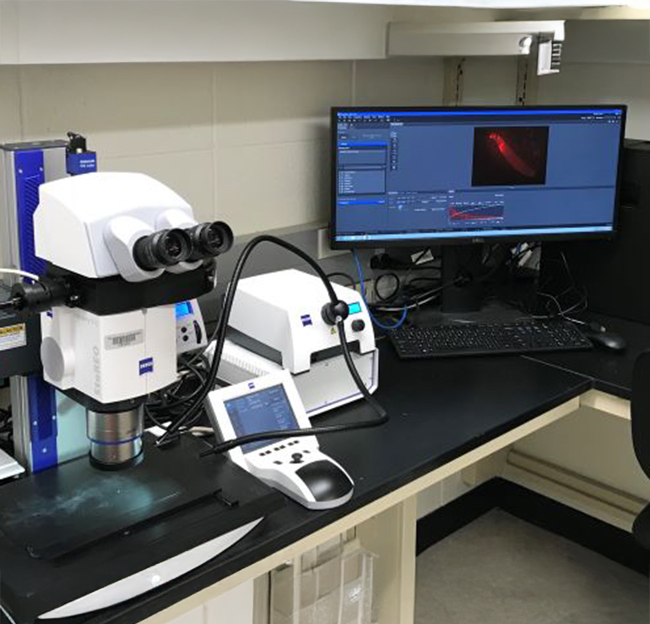Biology Research
Research in the department ranges from scales of the gene to the ecosystem, with many faculty bridging sub-disciplines of biology in their areas of interest.

A Top Research University
The University of Mississippi is designated as a R-1 Highest Research Activity University by the Carnegie Classification of Institutions of Higher Education. We are in an elite group of 2.5% of universities nationwide for world class research faculty, spending on research, and production of graduate students.
The Department of Biology is a comprehensive life science department with faculty working in many diverse areas of biology. We are a highly collaborative department, sharing interests and expertise. We train our graduate and undergraduate students to think broadly, to use interdisciplinary approaches, and to develop innovative insights into fundamental biological processes.
Research Areas
Research Facilities

Shoemaker Hall
The department occupies Shoemaker Hall, a five-story building on the main Oxford campus that houses laboratories that are equipped with instrumentation to support a range of life sciences research from molecular and cell biology through ecosystem ecology. Shoemaker Hall also houses our Imaging Core, Molecular Core, and the Pullen Herbarium.

Imaging and Molecular Core
The Biology Imaging Core is a shared and collaborative facility with the GlyCORE Imaging Corehouses and houses a variety of different microscopes including.
The Biology Molecular Biology Core is a self-service shared user facility that provides access to advanced instrumentation for the analysis of metabolites, proteins and nucleic acids.

Pullen Herbarium
An herbarium is a museum collection of plants and the information from where and when they were collected. This collection is used in teaching and in research to document changes in plant distribution through time.
The Department of Biology’s Pullen Herbarium is named after the first curator, Dr. Thomas M. Pullen, and now consists of 80,000+ plant specimens.

Off-Campus Research Sites and Collaborators
Biology field research also occurs at nearby sites in:
• Holly Springs National Forest
• Tallahatchie Experimental Forest
• Strawberry Plains Audubon Center
The Department has ongoing collaborations with scientists at:
• USDA National Sedimentation Laboratory
• Mississippi Department of Wildlife, Fisheries, and Parks
• University of Southern Mississippi Gulf Coast Research Laboratory

UM Field Station
The UM Field Station is a research and educational facility designed to serve visiting faculty and students, public and private schools, government agencies and the broader community of the Mid-South.
The mission of the University of Mississippi Field Station is to foster ecosystem stewardship by providing a natural laboratory and infrastructure for research, education and service, and by cultivating scientific information and understanding of upland watersheds in the lower Mississippi River Basin and similar habitats.
Biology Collaborators and Resources
Mississippi Center for Supercomputing Research
The Mississippi Center for Supercomputing Research (MCSR) provides computing resources, training, and support for faculty, staff, and students at all of Mississippi’s public Institutions of Higher Learning.
National Center for Physical Acoustics
The Jamie Whitten National Center for Physical Acoustics (NCPA) at the University of Mississippi stands as a pioneer of innovation in the field of physical acoustics. Since its establishment by Congress in 1987, NCPA has led the way in exploring a vast array of applications, from infrasound to ultrasound and beyond, setting benchmarks in research excellence.
National Center for Natural Products Research
The National Center for Natural Products Research (NCNPR) is at the forefront of harnessing the power of nature, ensuring quality, safety, and driving innovation in natural product research and development.
National Center for Computational Hydroscience and Engineering
We foster the growth of research in computational hydroscience and engineering, i.e., the development of new research and engineering tools, computational simulation models for conducting scientific research, engineering analysis and design, and environmental and ecological impact assessments in the area of natural resources (soil and water) conservation.The research and development activities of NCCHE cover a broad range of fields including watershed processes, channel network hydraulics, river morphology (meandering, bank erosion, etc.), flood analysis, dam break, sediment transport, water quality and pollutant transport, river training and restoration, and more.
Department of BioMolecular Sciences
We are a department of leaders in interdisciplinary life sciences dedicated to improving human and environmental health through education, biological and chemical research, and committed service.
Department of BioMolecular Sciences
We are a department of leaders in interdisciplinary life sciences dedicated to improving human and environmental health through education, biological and chemical research, and committed service.









